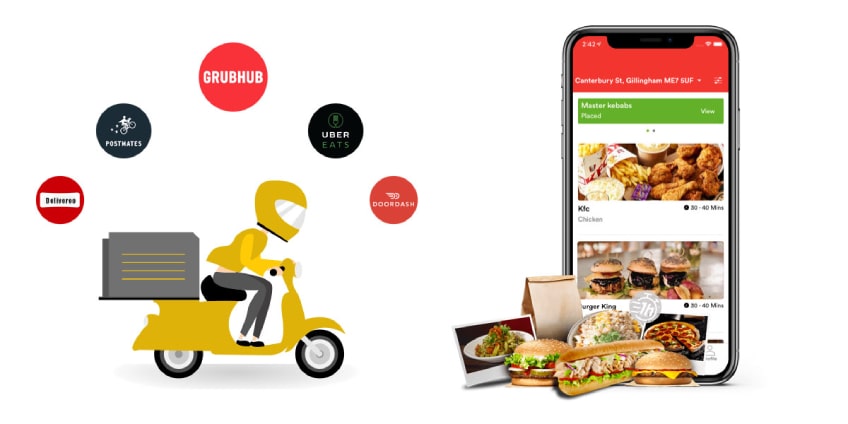The food delivery industry has exploded in recent years, reshaping how people order meals and how restaurants reach customers. Global leaders such as Uber Eats, DoorDash, and Zomato have set the bar high with seamless user experiences, real-time tracking, and wide restaurant networks. For entrepreneurs and businesses, the question isn’t whether to enter the market, but how to build a delivery app that can compete with the giants.
In this blog, we’ll walk through the essential steps, features, technology stack, and costs involved in developing a successful food delivery app in 2025.
Why Build a Delivery App Like Uber Eats, DoorDash, or Zomato?
Before diving into development, let’s understand the appeal:
- Market Growth – The global food delivery market is projected to cross $200 billion by 2025.
- Consumer Demand – Customers prioritize convenience, speed, and variety.
- Business Opportunities – Restaurants, grocery stores, and cloud kitchens are tapping into custom delivery app development to build direct customer relationships.
With the right strategy and execution, building a delivery app can unlock recurring revenue, brand visibility, and scalability.
Core Features of a Successful Delivery App
A food delivery app typically has three main panels—Customer, Restaurant, and Delivery Agent—along with an Admin Dashboard.
1. Customer App Features
- User Registration & Profile Management
- Restaurant Listings & Menu Browsing
- Advanced Search & Filters
- Real-Time Order Tracking
- Multiple Payment Options (UPI, cards, wallets, COD)
- Push Notifications & Offers
- Ratings & Reviews
2. Restaurant Dashboard Features
- Restaurant Profile Management
- Menu Management with pricing and availability
- Order Management System
- Analytics & Sales Reports
3. Delivery Agent App Features
- Driver Registration & Verification
- Order Acceptance & Rejection
- GPS Navigation & Route Optimization
- Earnings Dashboard
4. Admin Panel Features
- Manage Users, Restaurants, and Delivery Agents
- Commission & Revenue Management
- Analytics & Reporting Tools
- Marketing Tools (discounts, promo codes, loyalty programs)
Technology Stack for Delivery App Development
To build an app like Uber Eats or Zomato, you’ll need a scalable and secure tech stack:
- Frontend (Mobile & Web): React Native, Flutter, Swift (iOS), Kotlin (Android)
- Backend: Node.js, Django, Ruby on Rails
- Database: PostgreSQL, MongoDB, Firebase
- Cloud & Hosting: AWS, Google Cloud, Microsoft Azure
- Payment Gateways: Stripe, PayPal, Razorpay
- Maps & Navigation: Google Maps API, Mapbox
- Push Notifications: Firebase Cloud Messaging, OneSignal
Steps to Build a Delivery App Like Uber Eats
- Market Research & Validation
- Study competitors (Uber Eats, DoorDash, Zomato).
- Identify your niche (local cuisine, groceries, vegan delivery, etc.).
- Define Business Model
- Commission-based, subscription-based, or hybrid model.
- Hire a Development Team
- Choose a skilled custom delivery app development company with expertise in on-demand solutions.
- Design UI/UX
- Keep it simple, intuitive, and mobile-first.
- Develop the App
- Build and integrate all three panels (Customer, Restaurant, Delivery Agent).
- Test for Quality & Security
- Ensure smooth performance across devices.
- Launch & Market the App
- Use digital marketing, partnerships with restaurants, and referral programs.
- Continuous Updates
- Add features like AI-powered recommendations, voice ordering, or drone delivery as technology evolves.
Cost of Building a Delivery App
The cost to build a delivery app like Uber Eats depends on:
- Features & complexity
- Tech stack & integrations
- Region of the development team
On average:
- Basic MVP: $25,000 – $40,000
- Full-featured App: $60,000 – $120,000+
Future Trends in Delivery App Development
- AI-Powered Recommendations for personalized food suggestions.
- Green Delivery Solutions like e-bikes and drones.
- Multi-Service Apps combining food, groceries, and medicine delivery.
- Data-Driven Analytics for better customer engagement.
Final Thoughts
Building a delivery app like Uber Eats, DoorDash, or Zomato requires careful planning, advanced technology, and a strong value proposition. With rising consumer expectations, businesses need custom delivery app development to create scalable, secure, and engaging solutions.
Whether you’re a startup or an established business, investing in on-demand delivery app development in 2025 can open new growth opportunities and help you stand out in a competitive market.



